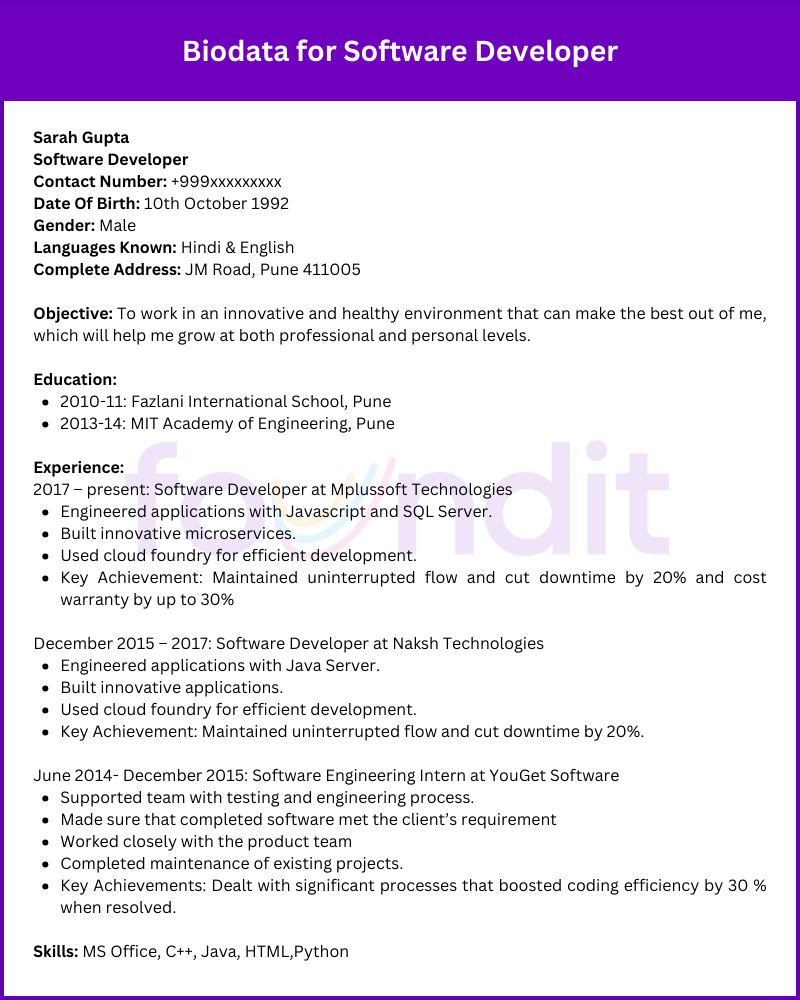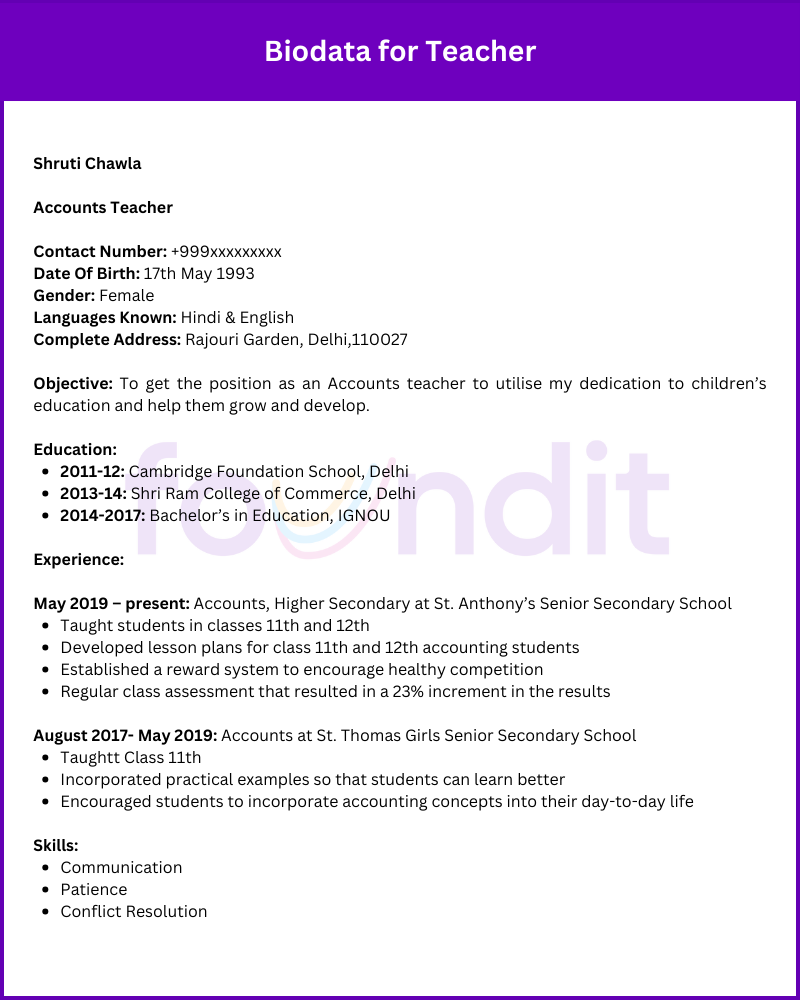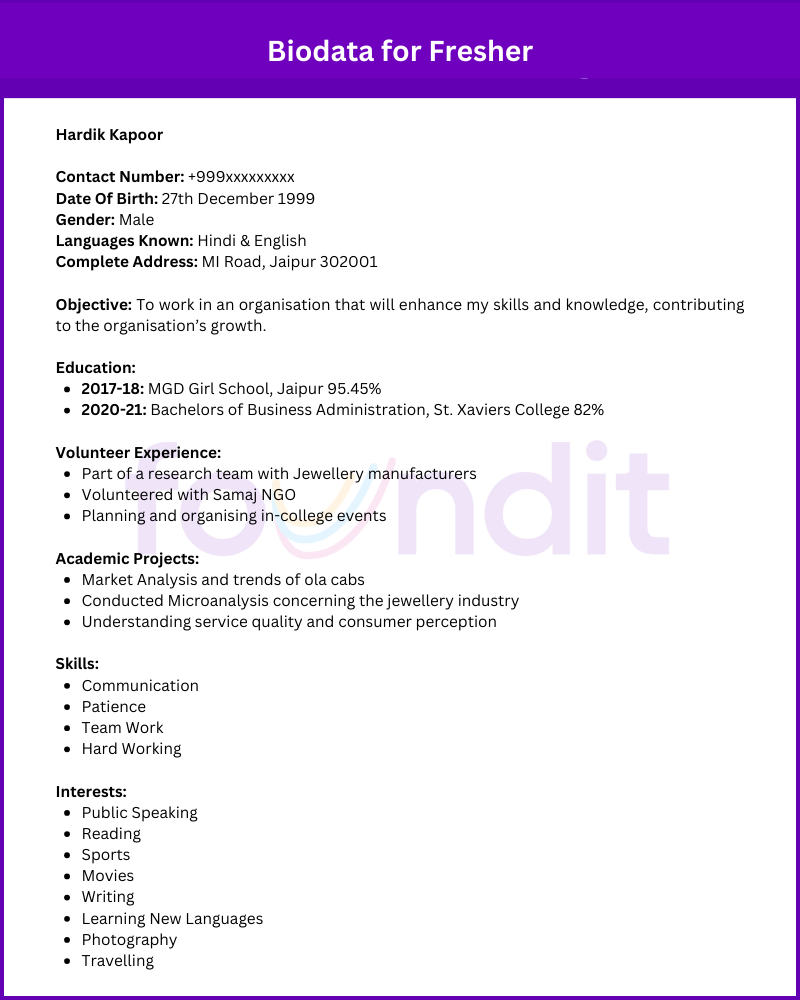Building strong biodata is essential to getting the best-fit role. It gives potential employers a peek into your qualifications, experience, and background.
Effective writing of one’s biodata greatly enhances one’s chances of being noticed among other applicants. Creating a well-organised biodata set will significantly increase your chances of being noticed in a crowded employment market. This article will review how to write biodata and provide some samples and tips to help you get started.
Understanding Biodata In Job Applications
Let’s start by defining and discussing the importance of biodata in a job application:
What is Biodata?
Biodata, short for biographical data, is commonly used for job applications. It encompasses various aspects of your professional life, such as personal information, education, acquired skills, and work experience.
Typically, biodata resumes span around three pages and provide a comprehensive overview of your professional background. Given the competitiveness of today’s world, it’s impossible to meet every candidate personally.
Therefore, hiring managers rely on biodata resumes to shortlist eligible candidates, making hiring more efficient.
Purpose of Biodata in Job Application
The biodata for the job acts as a professional profile, which is the first introduction to the company. Biodata intends to work in the company, making the task easy for the human resource team.
The purpose of including biodata in a resume is to introduce yourself to potential employers, highlighting your qualifications and abilities to increase your chances of securing the job.
Interested candidates must follow the proper biodata format to impress the managers. The better the biodata, the higher the chances of getting the interview call.
How Employers Use Biodata?
All the job seekers send their biodata for the job; employers select the eligible candidates for the interview. The following are how employers use your biodata:
- Analyse Trends: Every company receives a large pool of applications now and then. Over time, companies notice trends as people apply for similar positions. Employers of organisations study this data and analyse these trends to train prospective candidates. These trends will also help them frame job descriptions. They can submit new job postings accordingly to fit existing market trends.
- Identify Education: Specifications: Some job roles require special education qualifications. They have specific education or have minimum educational requirements. Employers look for an application that can fulfil specific academic qualifications, especially in cases where education is one of the essential components of their role. Sometimes, even if your qualifications are not exact, employers consider them to fulfil the bare minimum requirements.
- Identify Required Skills: Sometimes, some roles require a specific skill set. In this case, employers look for a skill set. Some skills can be ignored, whereas some cannot be bent.
- Identify Required Keywords: Many organisations use applicant tracking technology to handle the large numbers of resumes they receive. These smart-systems sort the application according to the criteria set by the employer. Resumes are given a percentage based on their preference. Employers set specific keywords to sort the biodata based on the position. Those who score highest are highlighted in the employer’s inbox, whereas those who score less are removed from the system.
- Determine Career Progression: Many job roles require employers to determine your career progression. They look at your professional journey, which gives them a clear idea of your career trajectory. This will help them decide if you are ready for a particular position.
- Assess Online Presence: As social media becomes more and more influential today, employers can find much information for their candidates. People spend a reasonable amount of time online, and their content shows what kind of person they are. If you post questionable content, it will discourage employers from going forward with your application.
Types of Biodata
Biodata is the first document you must submit to the employer to contain all the factual information about your career. Below are the types of biodata that are sent when seeking a job.
- For Government Job
- For Teachers
- For Freshers
- Creative Job
How to Write Biodata Format for Job Application
Biodata is used for job applications to get candidates to the interview round. There are different job types, and biodata must be written accordingly. Candidates must make sure that they follow a biodata format for the job. Below is the biodata format for different types of jobs.
1. Biodata Format For Basic Jobs
The biodata for a job must contain the following:
- Objective: Start by stating why you are applying. Then, list your career and life goals and how this position will help you achieve your goals.
- Personal Details: Your biodata resume must include basic details like Name, date of birth, address, gender, contact number, languages known, and anything else you think your employer must know.
- Educational Background: Describe your academic background in chronological order. Mention the year of passing from school/institution. You may or may not include a percentage.
- Job Experience: This is a significant section to include in your biodata format. List every job that you have done till now. When listing the experience, include awards or key achievements and critical responsibilities. This will help employees to get to know your achievements.
- Certificates and Internships: Mention all the internships you have done or certificates you have achieved during your internship or education.
- Hobbies and skills: Make sure to mention your skills and certificates. Mention any software or other language that you know. If a skill is related to a job, list it at the top.
- Volunteer experience: In today’s world, it is essential to volunteer. It will have a positive impact on your resume. Be it volunteering work with some NGO, it will benefit you for some organisation or in your school/college, so don’t forget to mention it.
- Professional Reference (For other professions): They are people who can vouch for you. This is based on your qualifications and insights into your strengths, work ethics, skills, and achievements.
- Educational Reference (For a teacher): You mention them in your biodata resume so the employer can contact them for an opinion about you as a teacher. It is done to reveal personal qualities, knowledge, and skills related to effective teaching.
- Current Location: Although including an address in your biodata is unnecessary, it is recommended. Including it in your biodata format for a job application looks less suspicious, and the applicant tracking system (ATS) prefers it. Your employer might need it for their records or background checks.
- Preferred Location: You will have to mention the preferred location so that employers also know if you want to do a job, or else they can give you a job in any area.
- Nationality: You may or may not include your nationality on your CV, but it is essential if you seek a job in another country.
- Current CTC: It entirely depends on the applicant if they want to mention their current CTC in their biodata model. It is not a necessity as, generally, this question is asked during the interview. But you can add your CTC to clear it beforehand.
- Expected CTC: You can mention your expected CTC, but make sure to express that it is negotiable; chances for an interview call may be reduced.
- Strengths & Weaknesses: Share your strengths and wellness. Discussing your strengths during the interview is essential to getting the job. You can mention your soft skills as weaknesses but are working to improve. Companies might have a particular requirement for their biodata.
You May Also Like:
| What is an Interview Process | Purpose of an Interview |
| How to Improve Analytical Skills | Answer What are Your Hobbies |
2. Biodata for Government Job
In a government job, specific rules and regulations differ from department to department. Your resume must be detailed. The biodata format for government jobs is given below.
- Objective
- Personal Information
- Educational Background
- Job Experience – Make sure job experience should be in detail. Mention your key responsibilities here.
- Certificates
- Details of internships
- Hobbies and skills
- Volunteer Experience
3. Biodata for Teachers
A biodata for teachers should contain experience and qualifications that fit the job. The format of a biodata for the teacher should include the following.
- Objective
- Personal Detail
- Educational Backgrounds:m Mention your degrees related to the subject you want to teach. Specific requirements of different academic institutions.
- Job Experience: Write your job experience in the same field.
- Research Papers: Include research papers from different institutions. This will be helpful in the case of the teacher’s biodata. This will strengthen your resume and increase your chances of getting a job.
4. Biodata for Freshers
Those who have recently graduated and want to work will have to apply as freshers and follow the biodata format for freshers; as your biodata will not include job experience, focus on skills achieved. Below is the format for freshers.
- Objective: Mention your potential career plans and objectives per the desired position.
- Educational Qualification: As you don’t have any job experience, this section becomes very important.
- Skills: Mention all your skills achieved in minor detail.
- Internships are the best way to show your experience. Candidates with internships are generally given preference. Mention the crucial responsibility and knowledge that you gained during an internship.
5. Creative Biodata
Creative biodata is a new kind that can be made using several colours, modern designs, photos, and illustrations. It can be used for photography, modelling, fashion design, graphic design, videography, etc. Candidates can go creative while making this biodata, although some things should be included. Below is the format for the creative biodata.
- Personal Details
- Skills
- Certificates
- List of Publications/Awards: It is essential to list all the awards and achievements in creative biodata.
- Educational Qualification
Sample Biodata for Resume
A simple biodata format focuses on personal particulars and educational and relevant experience. It includes personal information like Name, date of birth, gender, and residence. Some biodata for government jobs also ask for a photo. Candidates can submit their biodata on paper or via email in biodata format PDF. Below is the biodata template for your convenience.
Template 1: Biodata Format for General Jobs
Name
[Designation you are applying for]
[Contact Number]
[Date Of Birth]
[Gender]
[Languages Knows]
[Complete Address]
Objective: [Describe the objectives for your profession and workplace]
Education:
[Year] : [Educational Qualification]
Experience: [Mention all jobs and internships in detail also mention key achievements from each job]
Skills: [Mention all of your skill sets]
Example 1: Biodata for Software Developer
Now you know the basic format for biodata. Below is a biodata example.
| Sarah Gupta Software Developer Contact Number: +999xxxxxxxxx Date Of Birth: 10th October 1992 Gender: Male Languages Known: Hindi & English Complete Address: JM Road, Pune 411005 Objective: To work in an innovative and healthy environment that can make the best out of me, which will help me grow at both professional and personal levels. Education: 2010-11: Fazlani International School, Pune 2013-14: MIT Academy of Engineering, Pune Experience: 2017 – present: Software Developer at Mplussoft Technologies – Engineered applications with Javascript and SQL Server. – Built innovative microservices. – Used cloud foundry for efficient development. – Key Achievement: Maintained uninterrupted flow and cut downtime by 20% and cost warranty by up to 30% December 2015 – 2017: Software Developer at Naksh Technologies – Engineered applications with Java Server. – Built innovative applications. – Used cloud foundry for efficient development. – Key Achievement: Maintained uninterrupted flow and cut downtime by 20%. June 2014- December 2015: Software Engineering Intern at YouGet Software – Supported team with testing and engineering process. – Made sure that completed software met the client’s requirement – Worked closely with the product team – Completed maintenance of existing projects. – Key Achievements: Dealt with significant processes that boosted coding efficiency by 30 % when resolved. Skills: – MS Office – C++ – Java – HTML – Python |

Also Read:
| What is a Structured Interview | Accounting Skills For A Resume |
| What does a Product Manager Do | Resume Format For Freshers |
Template 2: Biodata Format for Teachers
Name
[Designation you are applying for]
[Contact Number]
[Date Of Birth]
[Gender]
[Languages Knows]
[Complete Address]
Objective: [Describe the objectives for your profession and workplace]
Education:
[Year] : [Educational Qualification]
Teaching Experience: [Mention all jobs and internships in detail; also mention key achievements from each job]
Skills: [Mention all of your skill sets]
Example 2: Biodata for Teacher
Now you know the biodata format for teachers. Below is a biodata sample.
Shruti Chawla
Accounts Teacher
Contact Number: +999xxxxxxxxx
Date Of Birth: 17th May 1993
Gender: Female
Languages Known: Hindi & English
Complete Address: Rajouri Garden, Delhi,110027
Objective: To get the position as an Accounts teacher to utilise my dedication to children’s education and help them grow and develop.
Education:
- 2011-12: Cambridge Foundation School, Delhi
- 2013-14: Shri Ram College of Commerce, Delhi
- 2014-2017: Bachelor’s in Education, IGNOU
Experience:
- May 2019 – present: Accounts, Higher Secondary at St. Anthony’s Senior Secondary School
- Taught students in classes 11th and 12th
- Developed lesson plans for class 11th and 12th accounting students
- Established a reward system to encourage healthy competition
- Regular class assessment that resulted in a 23% increment in the results
- August 2017- May 2019: Accounts at St. Thomas Girls Senior Secondary School
- Taughtt Class 11th
- Incorporated practical examples so that students can learn better
- Encouraged students to incorporate accounting concepts into their day-to-day life
Skills:
- Communication
- Patience
- Conflict Resolution

Template 3: Biodata Format for Freshers
Name
[Designation you are applying for]
[Contact Number]
[Date Of Birth]
[Gender]
[Languages Knows]
[Complete Address]
Objective: [Describe the objectives for your profession and workplace]
Education:
[Year] : [Educational Qualification]
Volunteer Experience:
Academic Projects:
Skills: [Mention all of your skill sets]
Interests:
Example 3: Biodata for Fresher
Now you know the biodata format for freshers. Below is a biodata example.
Hardik Kapoor
Contact Number: +999xxxxxxxxx
Date Of Birth: 27th December 1999
Gender: Male
Languages Known: Hindi & English
Complete Address: MI Road, Jaipur 302001
Objective: To work in an organisation that will enhance my skills and knowledge, contributing to the organisation’s growth.
Education:
- 2017-18: MGD Girl School, Jaipur 95.45%
- 2020-21: Bachelors of Business Administration, St. Xaviers College 82%
Volunteer Experience:
- Part of a research team with Jewellery manufacturers
- Volunteered with Samaj NGO
- Planning and organising in-college events
Academic Projects:
- Market Analysis and trends of ola cabs
- Conducted Microanalysis concerning the jewellery industry
- Understanding service quality and consumer perception
Skills:
- Communication
- Patience
- Team Work
- Hard Working
Interests:
- Public Speaking
- Reading
- Sports
- Movies
- Writing
- Learning New Languages
- Photography
- Travelling

Biodata Writing Tips That Everyone Should Know
When writing biodata for a job, remember that each application gets an average of 30 seconds of reading time. So this means you have approximately 30 seconds to leave an incredible impression on the employer. Below are the tips to follow for remarkable biodata.
- Make it easily understandable.
- To improve readability, utilise formatting tools to stylise content, separate parts, and varying font sizes.
- Be cautious about the personal information you reveal
- Focus on skills and qualifications that make you perfect for the job
- Highlight the main points that you want your employer to know
- Skip the unimportant part
- Refer to the biodata sample for more ideas.
Mistakes to Avoid While Creating a Biodata Format
Crafting a biodata can lead to common pitfalls, even with the best intentions. To make sure your biodata leaves the greatest impression possible, avoid the following mistakes:
- Don’t include personal information in your application that doesn’t relate to the job. Remain with pertinent and professional knowledge.
- Make sure the email address you use is formal. Steer clear of improper terms and nicknames.
- Grammar and spelling mistakes can undermine your credibility. Before submitting, make sure your biodata format is well proofread.
- Please recheck your contact details. An incorrect phone number or email address may result in missed opportunities.
- Make sure the structure of your biodata fits the needs and values of the organisation you are applying to.
Difference Between Biodata, Resume, and CV
Here’s a table that organises the information about biodata, resume, and CV:
| Document Type | Description | Ideal Use Cases |
| Biodata | A concise synopsis of a candidate’s background, education, abilities, and professional experience. It is brief and concentrates on important details. | Suitable for entry-level jobs or applications requiring little to no experience. |
| Resume | A thorough overview of a candidate’s educational and professional background and accomplishments. It is customised for particular job applications. | Ideal for seasoned professionals looking for work across various industries. |
| CV | A thorough overview of a person’s training, accomplishments, publications, talks, and research. It is more prevalent in academic and scientific domains. | Preferred for academic jobs, research, and grant and fellowship applications. |
Conclusion
As a job seeker, you might eagerly await the interview call; writing an attractive biodata format will help you get your ideal job. Professional biodata will help you get the position you seek. Before creating the biodata for a job, study the company and job you are applying for. Then, the biodata will be designed, considering all the tips and requirements to catch the attention of hiring managers. You can also create a biodata format in Word and send it through email.
FAQs on Format of Biodata
Q1. What is the difference between a resume and a biodata?
Ans: A resume that is one page long includes vivid details about your professional career. At the same time, biodata is a comprehensive summary of you and your professional life. Biodata is usually three pages long.
Q2. What weakness can I include in my job biodata?
Ans: Make sure to frame your weakness positively. You can add weaknesses like focusing too much on details, getting impatient with a project’s deadline, having trouble asking for help, Taking too much risk, and being spontaneous. Remember to mention that you are working on your weaknesses to improve your job.
Q3. Can I send a biodata format for a job through email?
Ans: Candidates can email the biodata format for the job pdf. Before submitting, double-check that you’ve followed the correct format. Write a crisp and precise subject line; do not skip it, or your biodata will be lost in the pool of applications.
Q4. What things should I consider before writing creative biodata?
Ans: When writing creative biodata, make sure to choose your fonts wisely, avoid word processors, Choose your colour palette wisely, Include samples of your work, Don’t plagiarise, Use proper prints and not photocopies, Create multiple resumes, check spellings, and Keep your biodata creative but formal.
Q5. What skills can I include in biodata for a job?
Ans: You can add leadership, teamwork, problem-solving, work ethics, interpersonal skills, communication skills, and flexibility.
| Related Topics | |
|---|---|
| How to Write Career Objectives for Engineer Resume | Resume Objective Examples and Writing Guide |
| Profile Summary in Resume for Freshers | Best Courses & Degrees after 12th MPC |




